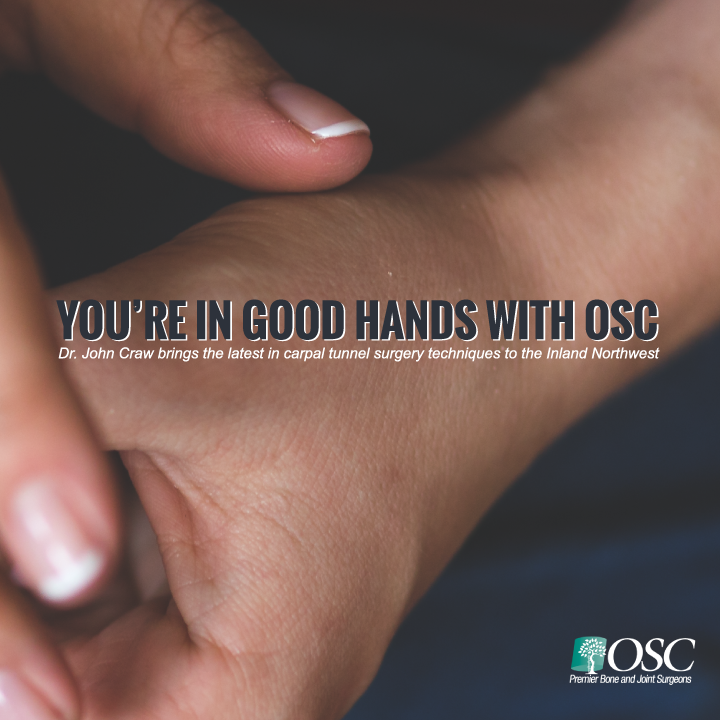
When it comes to the latest in carpal tunnel surgery, you’re in good hands with OSC.
Endoscopic carpal tunnel release surgery has been around for over 20 years, but there are still few surgeons trained to do the procedure. In fact, there are only a very small number of trained surgeons in the Inland Northwest that are able to perform the surgery at all.
This is one of the many reasons OSC is excited to have Dr. John R. Craw. After finishing his training with a hand surgery fellowship at Jackson Memorial Hospital in Miami, FL, Dr. Craw wrote about the technique in the soon-to-be published, ‘Operative Dictations in Plastic Surgery’.
Being one of the forerunners for this innovative technique, Dr. Craw’s expertise in endoscopic carpal tunnel release is what makes him unique among so many surgeons in the region. To give you a better appreciation for what sets this procedure apart, here’s an overview of what happens during a traditional carpal tunnel surgery.
A Quick Overview of Carpal Tunnel Surgery
Carpal tunnel syndrome occurs when the median nerve (controlling thumb movement and feeling on the fingers) is pinched or pressed inside of the carpal tunnel, a small opening inside the wrist that serves as a small conduit from the arm to the hand. This causes pain, tingling sensations and numbness, and can even limit the range of motion in your hand. Surgical treatment involves severing the flexor retinaculum (the ‘roof’ of the carpal tunnel) to reduce pressure on the median nerve, providing relief from the constriction.
Three Types of Carpal Tunnel Surgery
Open carpal tunnel release (traditional open technique): A one centimeter or so cut is made on the inside of the palm and the roof of the carpal tunnel is severed.
Mini open carpal tunnel release: A small incision is made in the palm and special instruments are used to blindly cut the ligament in both directions.
Endoscopic carpal tunnel release: The advantage is a smaller incision away from the palm so that daily activities don’t cause pressure on the incision after surgery. The ‘roof’ of the carpal tunnel is cut using the help of a very small camera allowing the surgeon to visualize the ligament from the underside. A special blade in front of the camera is used to divide the ligament making a smaller incision and aiding a faster recovery. For a better visualization of the procedure, here’s a short video animation.
Backed By Research
A prospective, randomized, multicenter study was published in the Journal of Bone and Joint Surgery, finding that during the first three months after surgery, the patients treated with the endoscopic method had higher satisfaction scores, greater grip strength, pinch strength, and hand dexterity when compared to the traditional open technique. The patients also had less scar tenderness in the first three months and returned to work on average 20 days earlier than those treated in the traditional open method.
…And More Research
A 2013 study published in Clinical Orthopaedics and Related Research compared the endoscopic technique to the “mini-open” technique. Each patient had surgery on both sides, one side with each method. After going through both techniques, one on each hand, the patients preferred the endoscopic release largely because of less postoperative pain from the scar.
If you’re dealing carpal tunnel syndrome,make an appointment with Dr. Craw at OSC today and see if you might be a candidate for carpal tunnel release surgery.
Here at OSC, a full recovery is within your grasp!
